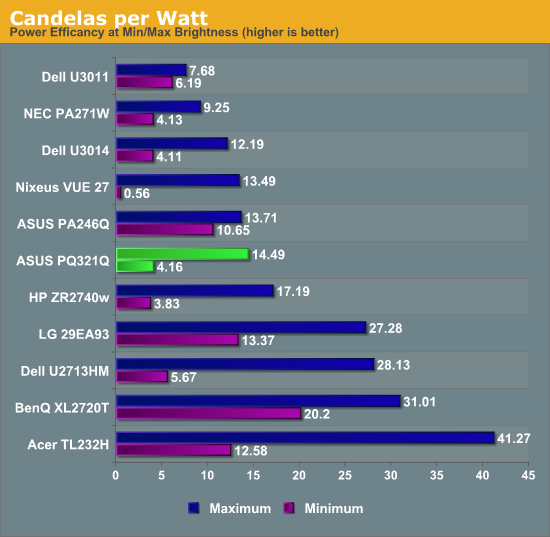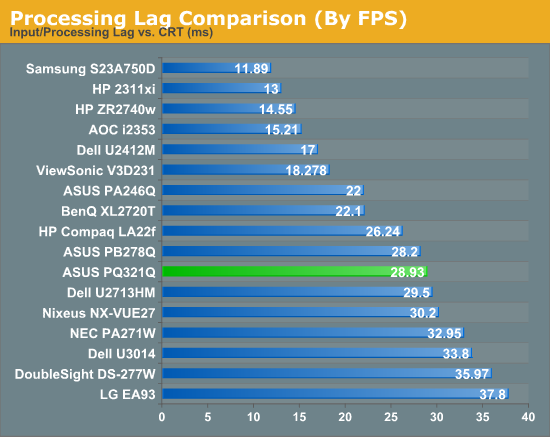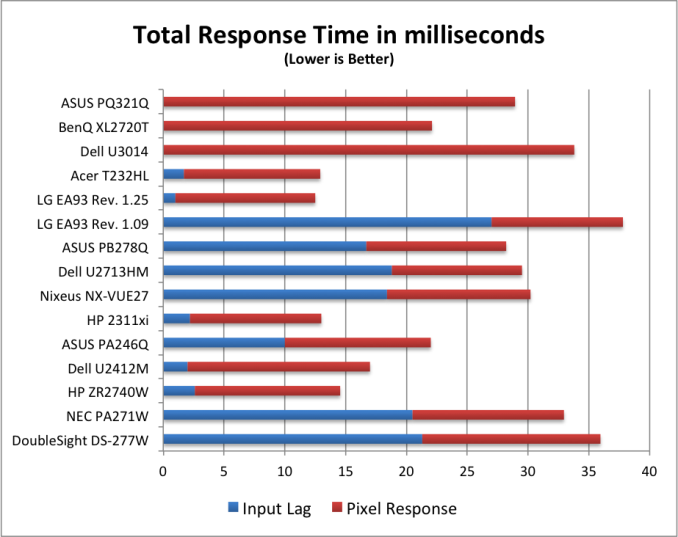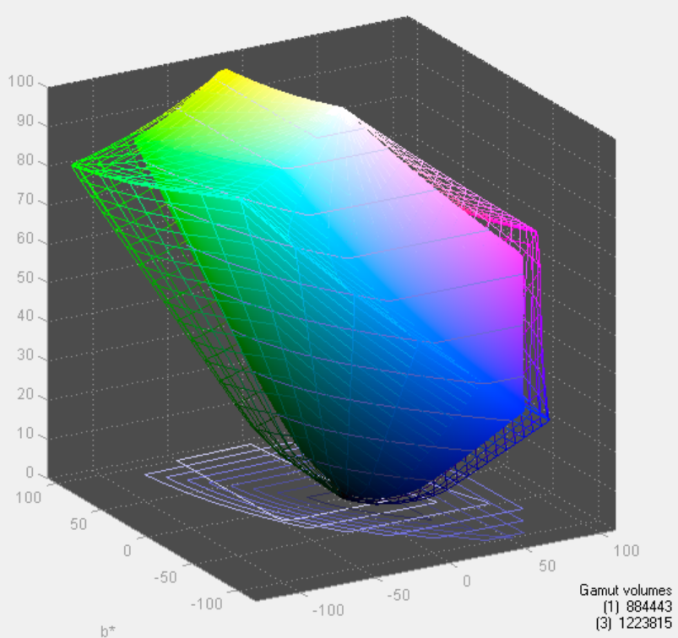ASUS PQ321Q UltraHD Monitor Review: Living with a 31.5-inch 4K Desktop Display
by Chris Heinonen on July 23, 2013 9:01 AM ESTUsing the updated metric for power usage, where I factor in maximum brightness and screen area and not just power usage, the ASUS PQ321Q falls right in the middle of the pack. For both maximum and minimum brightness it does OK but not incredible in comparison to other displays. With the greater transmission of IGZO I would have thought I might see better numbers from the ASUS, but I imagine power usage was very low on the list of concerns relative to other performance numbers.
Overall the ASUS PQ321Q draws a relatively average amount of power compared to other displays.


For testing input lag, I’m again reduced to using the Leo Bodnar lag tester over HDMI. This also means that the ASUS will have to scale the 1080p signal to be 2160p and fill the screen. Unlike before, I think this might be a more accurate test as many people will not be gaming at 2160p yet. Looking at the gaming numbers that our Ian Cutress found with a 4K display, you might want to run at 1080p for a little bit until setting up a 4x Titan rig becomes more affordable. Then again, if you can afford the ASUS PQ321Q, you might be buying a 4x Titan setup as well.
Back to the actual data, and the ASUS comes in at 28.93 ms of lag on average for the 3 measurement locations. This is better than the Dell U3014 monitor does, but slower than the BenQ XL2720T that is a native 1080p display. Given that you have scaling going on here, this actually is a pretty decent result I think.

Despite my GPU only being a GTX 660 Ti, I did try out a little bit of gaming on the ASUS. One question that was debated in Ian’s round-up was the necessity of MSAA at 4K resolutions. Measuring just now, I sit exactly 2’ away from the ASUS PQ321Q, with my eyes around dead center on the display. Turning on Half Life 2 (look, I’m not much of a gamer!), I can easily see the difference between no MSAA, 2x and 4x MSAA. The pixel density would need to be even higher, or I’d need to sit further away, for MSAA to not make a difference.
Without MSAA things still looked very sharp overall, but jagged lines are easy to spot if I look for them. You might be able to more easily get away with 2x or 4x instead of 8x MSAA, but you’ll want to have it enabled. Beyond that, the PQ321Q worked well for my casual gaming. Nothing recognized the display correctly at first, perhaps because of MST, but once in the game you can properly select the 3840x2160 resolution for it.
At the request of a commenter I'm adding some PixPerAn photos, trying to show best and worst case results. I've not used PixPerAn at all before, so feedback would be great. If I've done something wrong with it, I'll try to correct it ASAP.
Looking at the gamut, we see a value that indicates full sRGB gamut coverage. From our earlier images of the CIE diagram we know we don’t have full coverage of red, blue and magenta. It seems the extra green/yellow/orange section is large enough that we get a value that indicates a volume equal to the sRGB space, but some of that volume is an area outside of sRGB. It is close to the sRGB area, but not quite.


















166 Comments
View All Comments
chewbyJ - Tuesday, July 23, 2013 - link
this is great news! i've been wanting to replace my ancient Dell 2009WFP's with something larger, feel like experimenting with that Seiki SE39UY04 for $700 that got announced last month. hopefully you guys can get your hands on one of those soon and have something to compare with this ASUS model.can't wait to do Photoshop and Lightroom work on a giant 4k display and use a more expensive/high quality uniformity display for color accuracy of prints and media.
Panzerknacker - Tuesday, July 23, 2013 - link
btw, why is everybody worrying so much about gaming and graphics cards not handling 4k? I mean when you have that many pixels available it should be no problem to upscale, run the game at 1080p and simply upscale to 4k. I doubt there will be quality loss due to this and it will probably still look better than on a native 1080p screen.How does this work btw? Is it possible to let the screen do this by itself like with a TV? So you input 1080p, 1024 x 768, whatever ress, will it be upscaled by the screen to 4k and display fullscreen? This is really important for me because I would use the screen for everything, also playing older games that do not support 4k.
sheh - Wednesday, July 24, 2013 - link
Of course, like any current monitor, monitors do scaling. Some do it better, some worse, some let you configure more scaling options, some don't. It's probably best to handle scaling with the graphics card (/drivers), because that gives you, at least potentially, the most control.pattycake0147 - Tuesday, July 23, 2013 - link
The paragraph describing the black levels is missing a zero after the decimal and before the seven. Confused me until I looked at the graph.pandemonium - Wednesday, July 24, 2013 - link
Nice spreadsheet you got there. Clearly shows the necessary amounts per distance and size of display. More people need to be aware of such things!LordSegan - Wednesday, July 24, 2013 - link
"The ASUS PQ321Q is pricey, and I can’t say that getting three or four 30” 2560x1600 panels isn’t a better deal, but it’s not the same as having one display that looks like this. "I don't mean to be harsh, but this story needs more careful copy editing. There are run on sentences and other pretty amateurish errors.
Mondozai - Wednesday, August 21, 2013 - link
I don't mean to be harsh, but your comment needs more careful copy editing. You should spell it run-on sentences, not run on sentences.It helps having correct grammar when trying to correct others.
Just a tip.
bill5 - Wednesday, July 24, 2013 - link
Heh, what a surprise the reviewer loved a $3,500 monitor...It's almost like you get what you pay for
Confusador - Wednesday, July 24, 2013 - link
So when can I get a 23" 2560x1600 display? 32 is a bit much for me, but I'd love the dpi.sheh - Wednesday, July 24, 2013 - link
2014, probably.